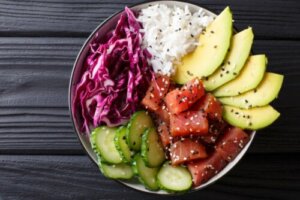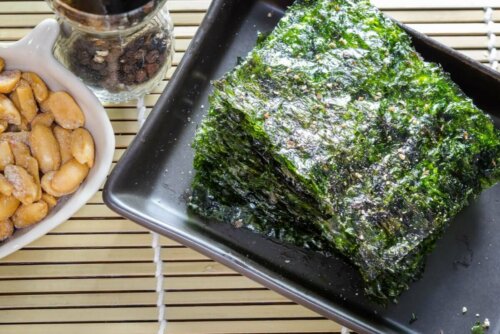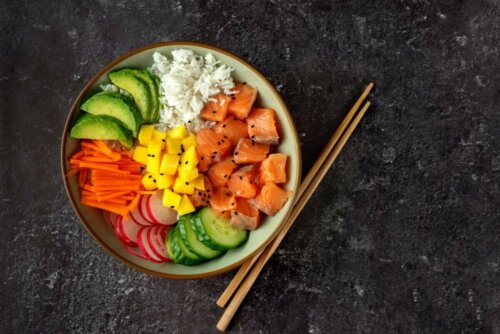How to Make Poke, A Very Popular Food


Written and verified by the nutritionist Florencia Villafañe
Perhaps you’ve heard of poke lately, as it’s a food that’s become very popular around the world. In this article, we’ll tell you more about it and show you a recipe.
Although it’s of Hawaiian origin and raw fish is its main ingredient, today, it’s one of the most popular dishes in European and American countries. Also, you can use other ingredients to make different versions of it.
What’s poke?
For starters, you should know that the word poke in Hawaiian means “to slice” or “cut crosswise into pieces.” This name is because this recipe is made with pieces of raw fish. To prepare the raw fish, you have to season it with soy sauce, sesame, and other condiments. Then, you have to mix it with vegetables.
In general, the traditional ways of making it are Aku, which is made with yellowfin tuna, and he’e, which is made with octopus instead of fish. However, it can also be made with raw salmon or shellfish.
Some of the fresh vegetables that are added to this dish are cucumber, seaweed, avocado, and onion. You have to serve this preparation in a bowl. If you prefer, you can also serve it with white rice.

Read on to learn more: How to Prepare Delicious Shrimp Tacos: 3 Recipes
What’s the history of this food?
Regarding the history of this dish, it first served to recharge the energy of the island’s fishermen. The locals prepared it with the fish that inhabit that area.
To do this, the locals gutted the fish, removed the skin, and cut it into pieces with their hands. Then, they preserved it with salt and added limu seaweed and typical seasonings, such as inamona (made from roasted nuts of the Kuku). After marinating it for some time, they mixed it with vegetables.
As we mentioned above, over the years, the dish varied due to influences from other countries. Of these variations, Japanese and Indian cuisine contributions stand out. This is because, in the 1970s, migration flows allowed inhabitants of those countries to arrive in the area.
Due to that, salmon, soy sauce, and rice were added to the dish. In fact, today, gourmet poke recipes include almond milk, quinoa, kale, tofu, chia seeds, and poppy seeds, among other ingredients.
Poke: a dish packed with nutrients
In addition to its refreshing flavor, this dish stands out due to its nutritional contribution from the combination of different ingredients. In this regard, scientific evidence shows that fish and shellfish are a source of protein and healthy omega-3 fatty acids.
For their part, seeds and nuts provide omega-3, -6, and -9, while vegetables provide fiber, iron, and calcium. For example, if you add chia seeds, the poke will contain a significant amount of fatty acids.
Even in vegetarian preparations that include tofu instead of meat, other ingredients provide protein. For all these reasons, we recommend you to try this food that’s packed with healthy nutrients.
You should also read: The Differences Between Vegan, Vegetarian and Flexitarian
How to make poke
Although there are many different ways to make poke, one of the simplest is the recipe you can find in the book The Poke Cookbook: The Freshest Way to Eat Fish.
We’ll share it below! Write down the ingredients that you’ll need and follow the steps to make this yummy and nutritious recipe.
Ingredients
To marinate the fish, you’ll need the following:
- 1 tablespoon of sesame oil or 1 tablespoon of white sesame seeds soaked for 2 hours
- The juice of 1 lemon
- 1 fresh ginger slice
- 1 tablespoon of soy sauce
These are the ingredients you’ll need for the poke itself:
- 3 tablespoons of cooked rice
- 100 grams of salmon
- 5 walnuts
- 1/4 of a cucumber
- 1/4 of red onion
- 5 radish slices
- 1/2 an avocado
To season and enhance flavors, use three green onion juliennes and hot sauce.
How to marinate the fish
- Firstly, dice the salmon and place it in a bowl or deep dish.
- Add the juice of one lemon, the soy sauce, the sesame oil (or the seeds), and the ginger slice.
- Then, mix everything and let the fish marinate for at least 20 minutes.
- Cover it with plastic wrap or a lid and store it in the refrigerator while you work on the next step.
As this recipe is raw, we recommend making sure that all the ingredients are clean and in good condition.

What you need to do before assembling the poke
- Next, chop the onion and let it soak in hot water for 15 minutes to lower the acidity.
- After that, slice the cucumber, radish, or avocado.
- Chop the green onion.
- Once you cut everything, it’s time to assemble the bowl.
How to assemble the poke bowl
- Pour the rice in a bowl.
- Take out the marinated salmon from the refrigerator and arrange it (however you prefer) in the same container.
- Add the vegetables.
- On top of everything, pour the hot sauce (to taste) and add the walnuts and the chives.
Conclusion
As you probably realized in this article, in addition to this being a very popular dish, it’s also a mix of beneficial nutrients and it’s very easy to make. Keep in mind that this is only a suggested poke recipe, meaning you can vary it however you like!
All cited sources were thoroughly reviewed by our team to ensure their quality, reliability, currency, and validity. The bibliography of this article was considered reliable and of academic or scientific accuracy.
- Choy, S. (2004). Sam Choy’s Little Hawaiian Poke Cookbook. Mutual Pub.
- Quelal, María Mosquera, María Reinoso García, and Wilson Vásquez Castillo. “Composición lipídica y caracterización de los ácidos grasos de la semilla de chía (salvia hispánica l.).” Industrial data 20.2 (2017): 15-20.
- Cheng M. El libro de cocina de Poke: la forma más fresca de comer pescado. 2017
- Nutrientes en los alimentos. Anexo1. Disponible en: http://www.fao.org/3/y5740s/y5740s16.pdf
- Valenzuela, A. (2005). El salmón: un banquete de salud. Revista chilena de nutrición, 32(1), 8-17.
- Leiva, Anabel Beitia. “Proteínas de origen vegetal y su interés nutricional.” Recuperado http://zahartzaroa. artematiconorte. com/pdf/alimentacion/PROTEINAS VEGETALES. pdf (2015).
This text is provided for informational purposes only and does not replace consultation with a professional. If in doubt, consult your specialist.








